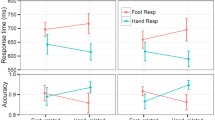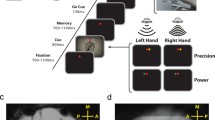Abstract
Results of kinematic studies on the control of the reaching–grasping motor act (Gentilucci 2003, Exp Brain Res 149:395–400) suggest that grasp is guided by a single motor representation, which codes all the possible types of interactions with the objects. Neuroimaging studies in humans (Chao and Martin 2000, Neuroimage 12:478–484; Grabowski et al. 1998, Neuroimage 7:232–243; Grafton et al. 1997, Neuroimage 6:231–236; Martin et al. 1995, Science 270:102–105) suggest that these representations are coded in the premotor cortex and are automatically activated when naming the object or viewing it without the execution of an overt action. If an object motor representation is accessed by language, naming of object properties related to sensory-motor transformation can automatically influence the object motor representation. This hypothesis was verified by behavioural experiments (Gentilucci and Gangitano 1998, Eur J Neurosci 10:752–756; Gentilucci et al. 2000, Exp Brain Res 133:468–490; Glover and Dixon 2002, Exp Brain Res 146:383–387), which showed that automatic reading (and probably silent naming; MacLeod 1991, Psychol Bull 109:163–203) of adjectives related to object properties analysed for planning the reaching–grasping motor act influenced the control of the arm movement. In a new study it was determined whether the class of a word can be a factor selectively influencing motor control. Participants were required to reach for and grasp an object located either on the right or on the left, and to place it on the opposite side. Either a verb ("place" SPOSTA versus "lift" ALZA) or an adjective ("lateral" LATERALE versus "high" ALTO) was printed on the target. A greater influence of the verbs than of the adjectives was observed on the kinematics of the action. In particular, when the verb ALZA was printed on the object, hand-path height and vertical component of arm velocity were higher than when the adjective ALTO was presented on the object. The data support the hypothesis that the object motor representation is mainly coded in terms of possible interactions with the object.



Similar content being viewed by others
References
Arbib MA (1990) Programs, schemas and neural networks for control of hand movement: beyond the RS frameworks. In: Jeannerod M (ed) Attention and performance XIII: motor representation and control. Lawrence Erlbaum, Hillsdale NJ, pp. 111–138
Chao LL, Martin A (2000) Representation of manipulable man-made objects in the dorsal stream. Neuroimage 12:478–484
Gangitano M, Daprati E, Gentilucci M (1998) Visual distractors differentially interfere with the reaching and grasping components of prehension movements. Exp Brain Res 122:441–452
Gentilucci M (2002) Object motor representation and reaching–grasping control. Neuropsychologia 40:1139–1153
Gentilucci M (2003) Object familiarity affects finger shaping during grasping fruit stalks. Exp Brain Res 149:395–400
Gentilucci M, Gangitano M (1998) Influence of automatic word reading on motor control. Eur J Neurosci 10:752–756
Gentilucci M, Castiello U, Corradini ML, Scarpa M, Umiltà C, Rizzolatti G (1991) Influence of different types of grasping on the transport component of prehension movements. Neuropsychologia 5:361–378
Gentilucci M, Chieffi S, Scarpa M, Castiello U (1992) Temporal coupling between transport and grasp components during prehension movements: effects of visual perturbation. Behav Brain Res 47:71–82
Gentilucci M, Toni I, Chieffi S, Pavesi G (1994) The role of proprioception in the control of prehension movements: a kinematic study in a peripherally deafferented patient and in normal subjects. Exp Brain Res 102:483–494
Gentilucci M, Benuzzi F, Bertolani L, Daprati E, Gangitano M (2000) Language and motor control. Exp Brain Res 133:468–490
Glover S, Dixon P (2002) Semantics affects the planning but not the control of grasping. Exp Brain Res 146:383–387
Goodale MA, Meenan JP, Bülthoff HH, Nicolle DA, Murphy KJ, Racicot CI (1994) Separate neural pathways of object shape in perception and prehension. Curr Biol 4:604–610
Grabowski TJ, Damasio H, Damasio AR (1998) Premotor and prefrontal correlates of category-related lexical retrieval. Neuroimage 7:232–243
Grafton ST, Fadiga L, Arbib MA, Rizzolatti G (1997) Premotor cortex activation during observation and naming of familiar tools. Neuroimage 6:231–236
Jakobson LS, Goodale MA (1991) Factors affecting higher-order movement planning: a kinematic analysis of human prehension. Exp Brain Res 86:199–208
Jeannerod M (1988) The neural and behavioural organization of goal-directed movements. Oxford University Press, Oxford
MacLeod CM (1991) Half a century of research on the Stroop effect: an integrative review. Psychol Bull 109:163–203
Martin A, Haxby JV, Lalonde FM,Wiggs CL, Ungerleider LG (1995) Discrete cortical regions associated with knowledge of color and knowledge of action. Science 270:102–105
Milner AD, Goodale MA (1995) The visual brain in action. Oxford University Press, Oxford
Oldfield RC (1971) The assessment and analysis of handedness: the Edinburgh Inventory. Neuropsychologia 9:97–113
Acknowledgements
I wish to thank L. Caselli and C. Secchi for their help in carrying out the experiments, and G. Cossu for comments on the manuscript. The work was supported by grant from MIUR (Ministero dell'Istruzione, dell'Università e della Ricerca, Italy).
Author information
Authors and Affiliations
Corresponding author
Rights and permissions
About this article
Cite this article
Gentilucci, M. Object motor representation and language. Exp Brain Res 153, 260–265 (2003). https://doi.org/10.1007/s00221-003-1600-8
Published:
Issue Date:
DOI: https://doi.org/10.1007/s00221-003-1600-8




